Disc Brakes and (Much) More for Trek's New Madone
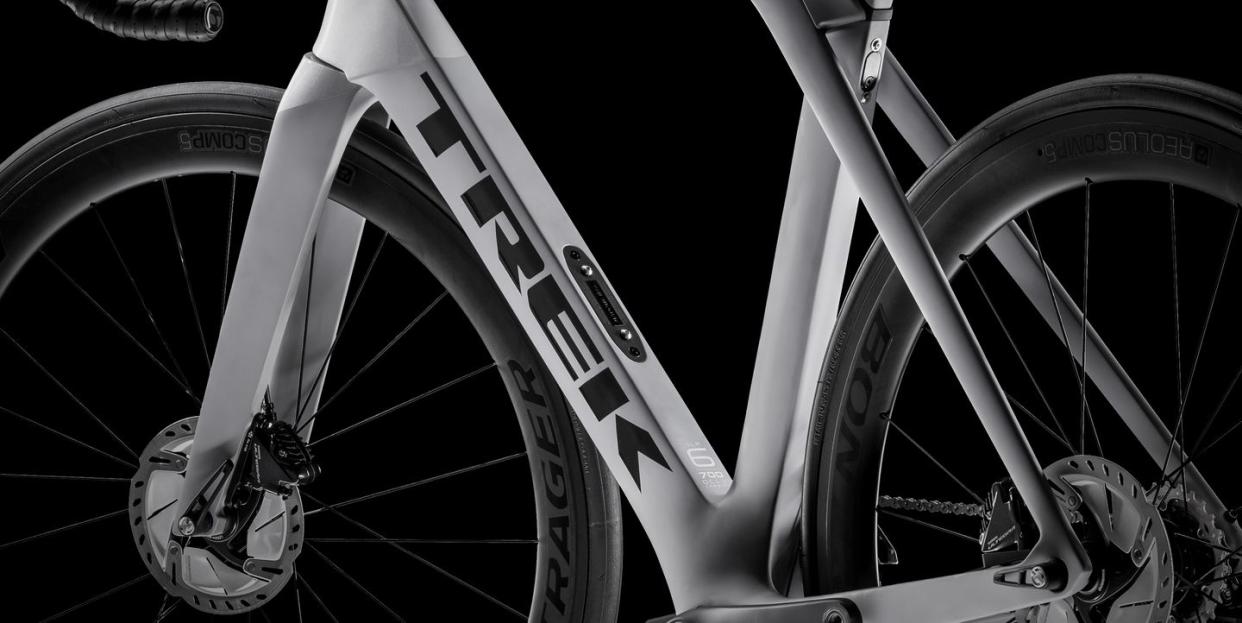
Leading up to the 2018 Tour de France there's been a dizzying pace of aero-road bike launches with new bikes rolling out from Cannondale, Specialized, 3T, and BMC. The latest in this week of speed: Trek's new Madone SLR.

Underneath the Madone SLR's familiar face is a long list of updates and improvements. The addition of a disc brake option is the most significant, but Trek's team also updated the bike's bump-absorbing IsoSpeed seat tube, made the cockpit more adjustable, updated the geometry, and freshened the Madone's graphics and colors.
Many Madone Models
In sharp contrast to some of the new aero bikes that have rolled out recently, Trek offers the new Madone in a bunch of options: rim or disc brakes, for electronic and mechanical drivetrains, and in women's and men's builds.
The Madone SLR version comes in eight models that range in price from $12,500 to $6,000. All SLR models use an integrated seat mast, and are equipped with the same Madone-specific bar and stem. All models get tubeless ready wheels, 50/34 chainrings and 11-28t cassettes. The Madone uses the BB90 bottom bracket system.
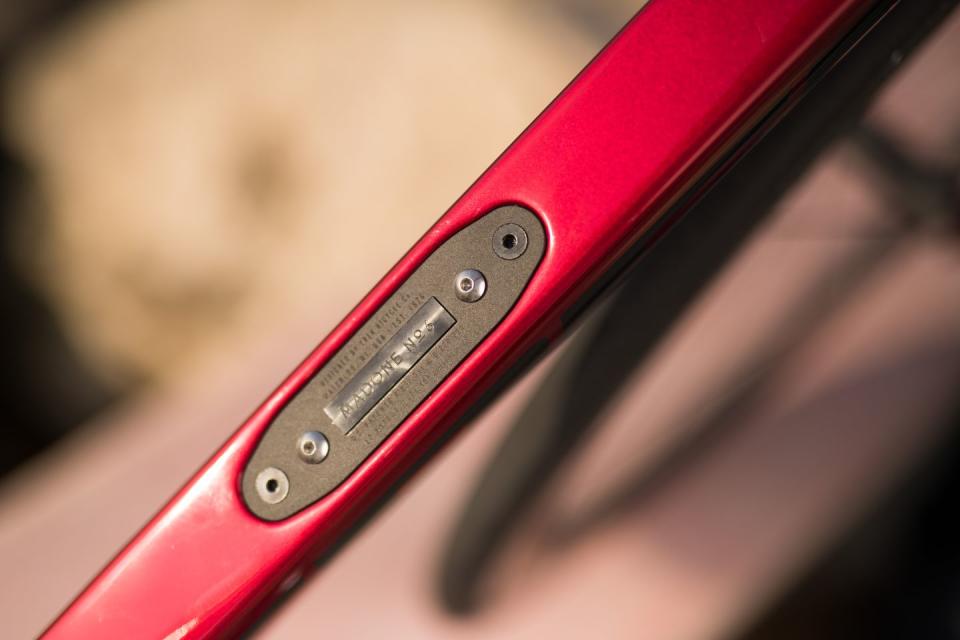
A revised Control Center is located under the downtube bottle-cage mount and holds the Di2 junction box and battery. It also anchors the rear brake hose to prevent it from rattling in the Madone's sizable downtube.
All Madone SLR models are made with Trek's highest grade OCLV700 carbon fiber composite. At this time, the Madone SLR models are made overseas and not in Trek's Wisconsin factory.

The top-of-the line Madone SLR 9 Disc comes with Shimano's Dura Ace Di2 disc group, Bontrager Aeolus XXX 6 Disc wheels, 25mm Bontrager R4 320tpi tires, and carbon-railed Bontrager Montrose Pro saddle. With standard paint, this SLR 9 Disc is $12,000; choosing one of the "premium" paint schemes adds $500. Note that, unlike some of its competitors, this model is not equipped with a power meter.
The SLR 8 ($7,500; $8000 with premium paint) is a rim-brake model. It's built with Shimano Dura Ace mechanical drivetrain, Bontrager Aeolus Pro 5 wheels, 25mm Bontrager R3 tires, and Bontrager Montrose Elite saddle.
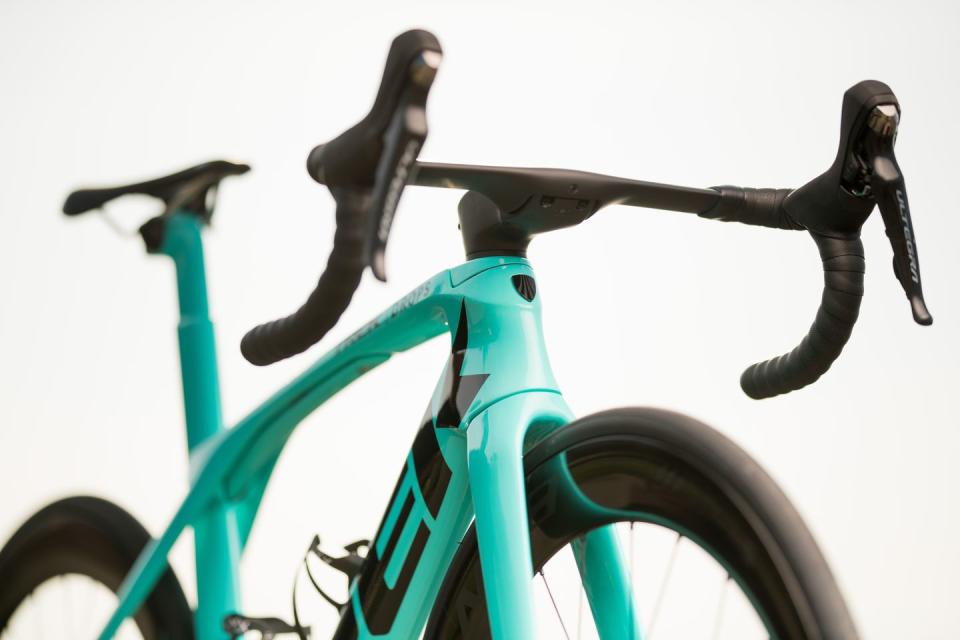
The SLR 6 Disc has the biggest range of models. This model is built with Shimano Ultegra mechanical group, Bontrager Aeolus Comp 5 Disc wheels, 25mm Bontrager R3 wheels, Bontrager Montrose Elite saddle. It is available men's and women's build. With standard paint, the SLR 6 Disc is $6000; with premium pain it's $6,500.
Men's and women's builds use the same frame, with the same geometry-only finish and some parts (saddle for example) are changed for the women's builds.
In addition to these prebuilt models, Trek offers the Madone SLR through its Project-One custom parts and paint program. P1 bikes will be offered with more parts options, and huge range of paint customization options.

The $4,000 Madone SL 6 is a carry over of the previous generation's frame, though built with lower-grade OCLV500 carbon. This model is rim-brake only, with standard bar and stem compatibility. It's built with a Shimano Ultegra mechanical drivetrain, Bontrager Aeolus Comp 5 wheels, 25mm Bontrager R2 tires; Bontrager Montrose Comp saddle, and Bontrager stem and aero-top handlebar.
Weights
The Madone SLR disc frame weighs 1,112 grams; the rim-brake frame weighs 1,131 grams (weights are for a 56cm frame with seat post, but no paint). Note that the rim-brake frame weighs more than the disc brake frame. Fork weights are 421 grams for disc, and 378 grams for rim.
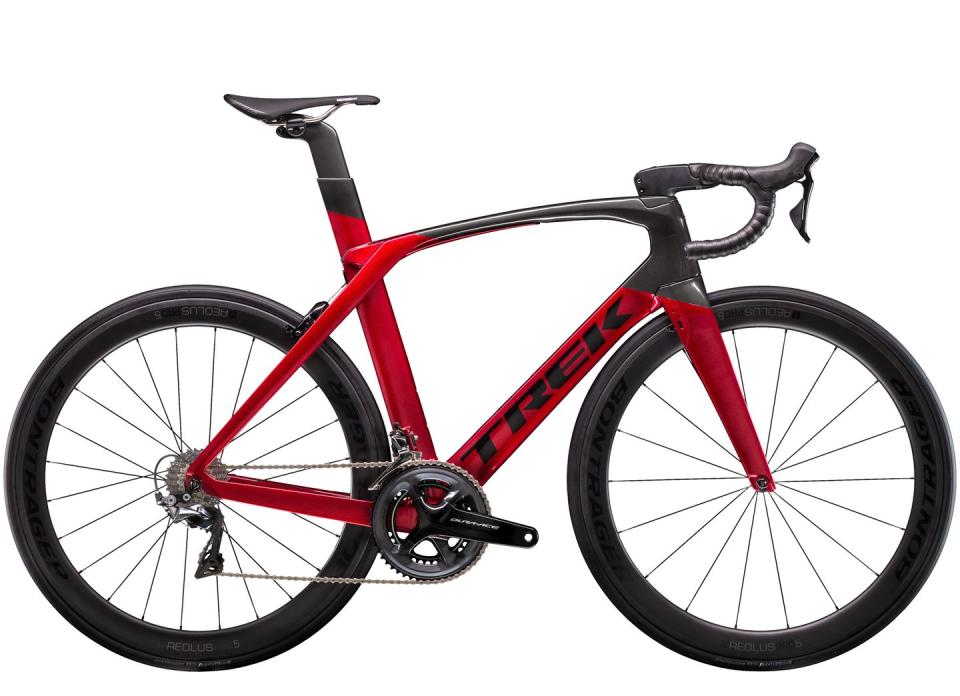
The Madone SL frame weighs 1,112 grams with seat post and the fork adds another 376 grams.
Trek claims a complete SLR 9 Disc weighs 7.405 kg (16.32 pounds). The SLR 8 with rim brakes has a claimed weight of 7.087kg (15.62 pounds)
Disc Brakes
Like almost all new disc-equipped bikes, Trek uses Shimano's flat-mount caliper attachment standard (Dura Ace and Ultegra calipers come only in this style), with 12x142mm (rear) and 12x100mm (front) thru axles.
With disc brakes, the new Madone has slightly more drag (3,216 grams compared to 3,202) than the previous generation (rim-brake-only bike). The 14 gram difference met Trek's design goal of 30 grams or less of the previous generation.
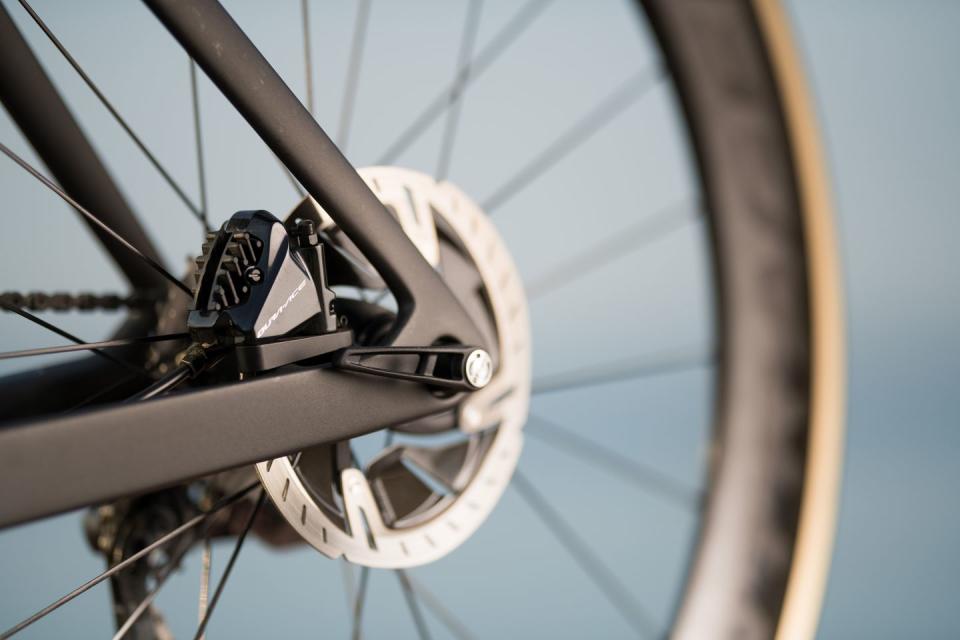
That drag difference is averaged across a -12.5-degree to 12.5-degree yaw sweep, which is a little narrower than most brands test–Specialized tests -15 degrees to 15 degrees and Cannondale tested its new SystemSix (and its competitors) between -20 and 20 degrees. Trek claims that its range is suitable, saying that it
is the most common yaw a rider experiences based on real-world data-collection studies."
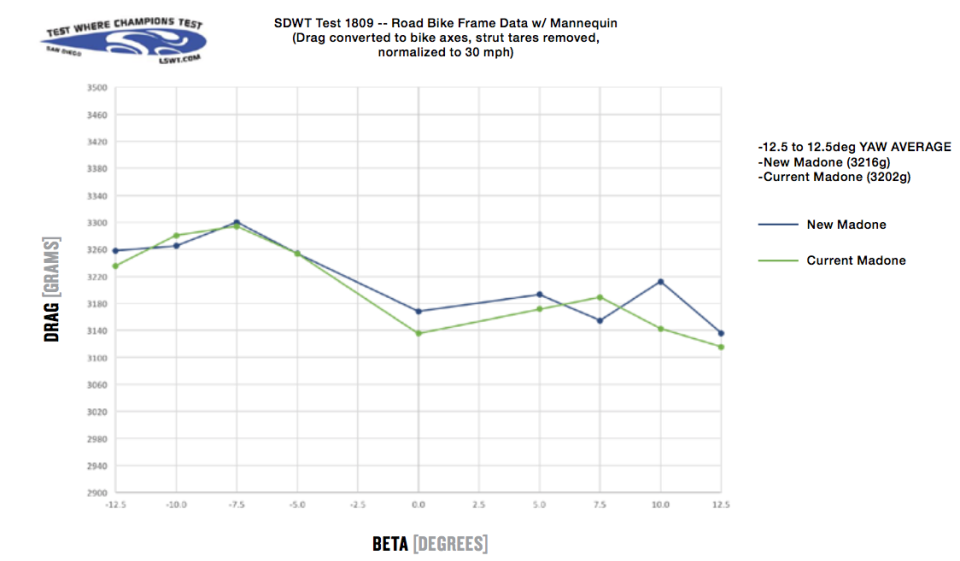
The wind angle you experience on the road is subject to many factors, perhaps none greater than your fitness. The faster you ride, the straighter the wind you experience becomes. At some angles the new Madone SLR Disc is faster than the previous generation Madone with rim brakes; but at most angles tested, it is a tiny bit slower.
Trek did not provide any information about the Madone's performance relative to its competitors. Not that it would have mattered anyway as the aero category has been completely upended this week.
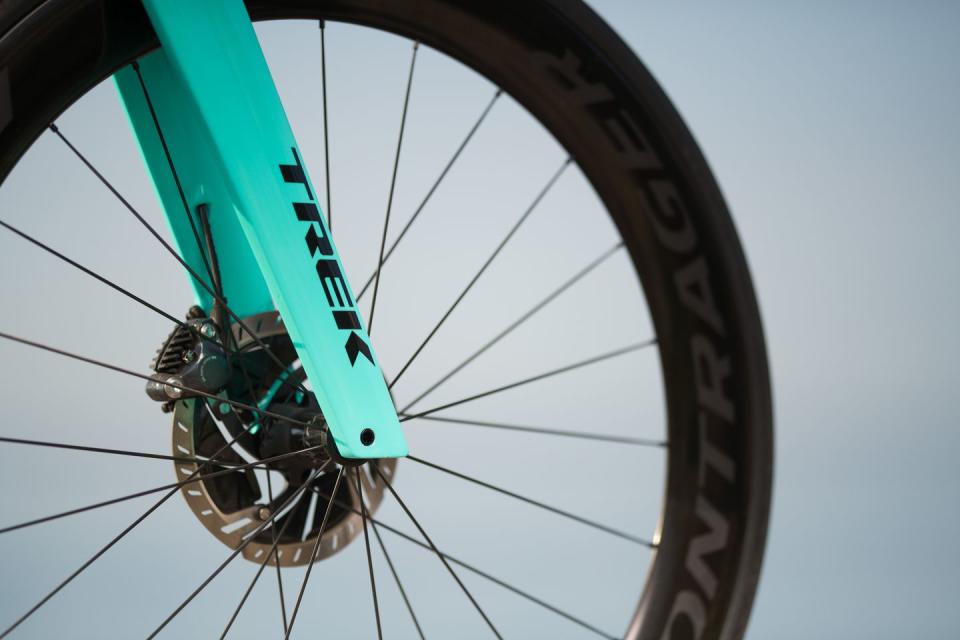
A molded-in tube guides the front brake hose for easier assembly or replacement.
Maximum officially allowable tire width for the disc brake Madone is 28mm, which, in the new aero disc world, is on the smaller side. The new Venge, for example, can take up to 32mm-wide tires.
New Rim Brakes
While disc brakes seem to have established themselves as the standard for high-end road bikes, rim brakes still have their fans. Trek didn't neglect the trusty, light, and elegant rim brake when designing the Madone SLR. In fact, it made a new one.
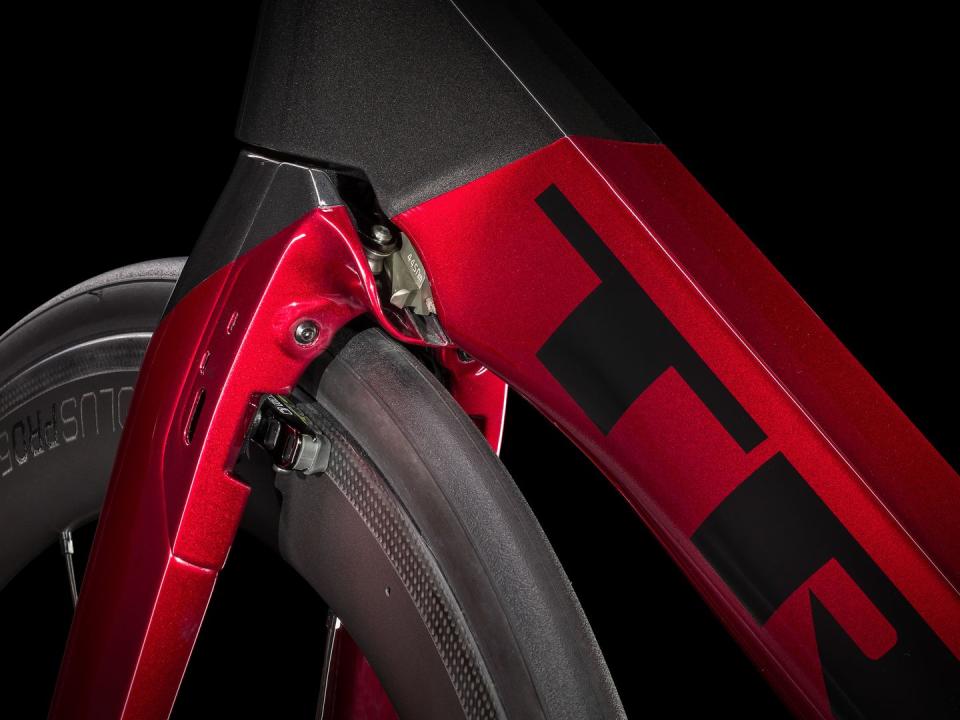
The biggest noticeable change is that the front brake has been relocated to the back of the fork, which improves the (rim brake) frame's aerodynamics slightly (Trek did not provide aero testing data). The new front brake is five grams lighter than the one fitted to the previous Madone; the new rear brake is the same weight as the previous brake design.
An updated brake-arm design provides independent spring tension adjustment, and independent adjustment of arm position. The latter allows the rider to easily adjust the brake arms to accommodate (external) rim widths of 23 to 28.5mm without fiddling with the brake cable. Maximum, official, tire size on the new Madone SLR for rim brakes is 25mm.
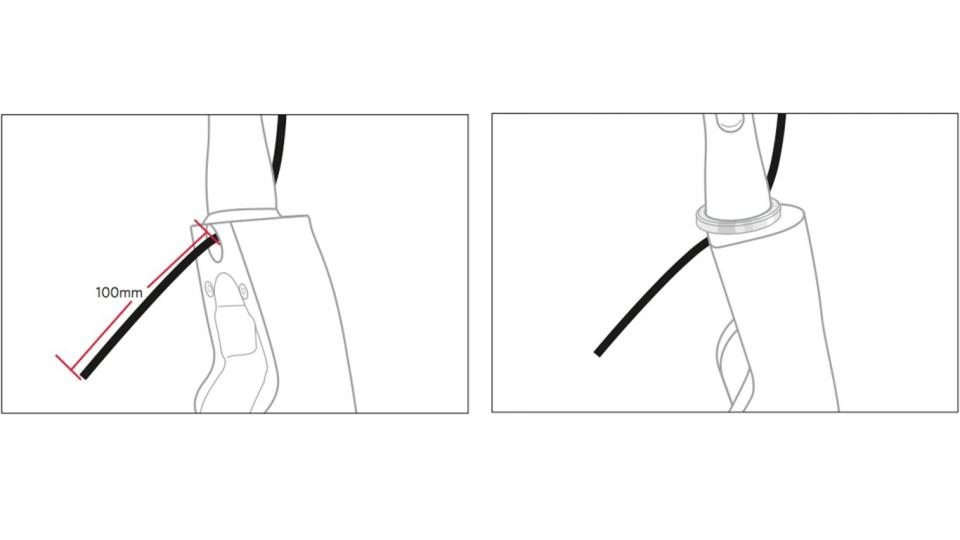
Somewhat crazily, the front-brake housing goes down the front of the fork steerer, then goes into a hole in the steerer above the lower headset bearing, then out the crown. I assume Trek's engineers have done their homework, but I have to admit that a hole in the fork steerer so close to the crown gives me a little pause.
More Adjustable IsoSpeed, Now With Damper
Borrowing an idea first seen on the Domane SLR, the Madone's IsoSpeed Decoupler, which allows the seat tube more freedom to flex now offers rider-adjustable stiffness (it was fixed in the previous generation). The slider is located under the top tube, and is adjusted by loosening a single bolt.
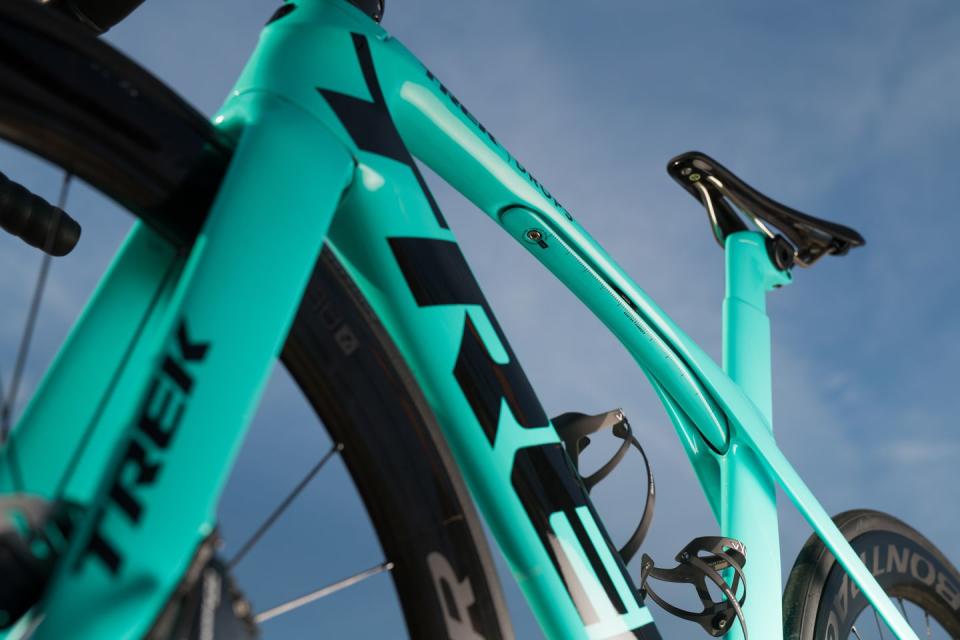
At the extremes of the adjuster's position, the Madone SLR can be up to 22 percent stiffer, or up to 17 percent softer than the previous Madone frame. The minimum and maximum vertical compliance numbers vary slightly by frame size (see the chart), but you can see all sizes have very similar values.
Another significant update to the Madone's IsoSpeed Decoupler is the addition of a small damper. This is the first time a damper has been added to any of Trek's IsoSpeed-equipped bikes. The damper is a bit of squishy material that, when displaced by a bump, slows the IsoSpeed's return to its original position. The Madone's white paper claims the "damper is reducing the amount rebound magnitude after impact by as much as 13 percent."
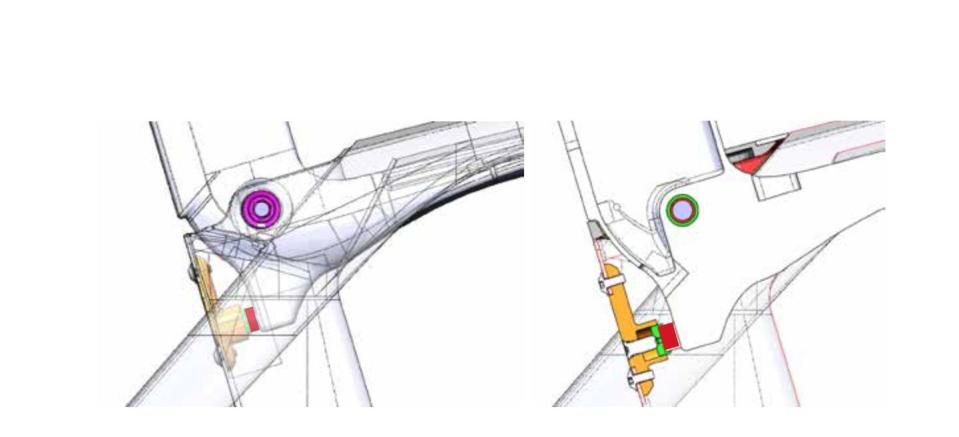
The should help reign in some of the bounciness that could occur when riding an undamped IsoSpeed equipped bike. This will be particularly welcome now that the Madone's IsoSpeed can provide more vertical deflection. I would suspect Trek will add the damper to future versions of its other IsoSpeed equipped bikes, the Domane and the Boone.
Revised Cockpit
The previous generation of Madone arrived with a sleek, integrated carbon bar and stem, which limited bar position options, and made changing stem length more involved (because the whole unit had to be replaced). It also offered fewer stem-length/stem-angle/bar-width/bar-shape options than a two-piece system.
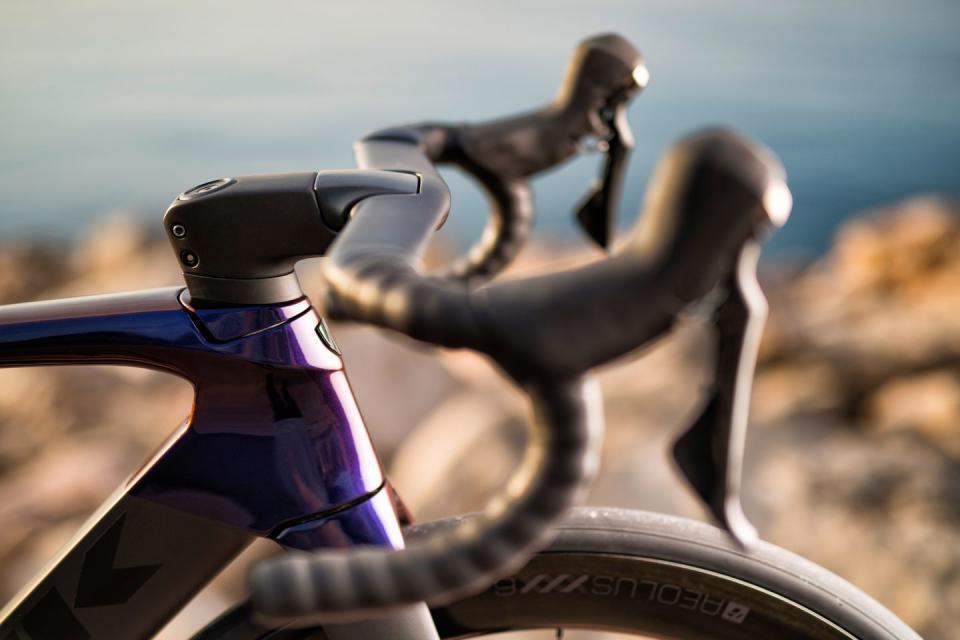
For the new Madone SLR, Trek's product team has developed a two-piece bar and stem that maintains the same aerodynamic properties of the one-piece system, but offers a much wider range of fit combinations (40 versus 26 for the one-piece). Additionally, the two-piece system provides +/- five degrees of bar roll.
Stems are offered in -7 degrees and -14 degrees rise, and in 90, 110, 110, 120, and 130mm lengths. The new Madone bar has back-swept tops (the old bar had straight tops) and comes in 380, 400, 420, and 440mm (center to center) widths. All bars have 93mm reach and 123mm drop–note that Bontrager measures reach a bit differently than other brands, so its reaches look long in comparison.

Though it's now a tw0–piece system, the controls still run through the middle of the stem, so a stem swap still requires uninstalling the brake and derailleur cables/wires/hoses/housings from the frame.
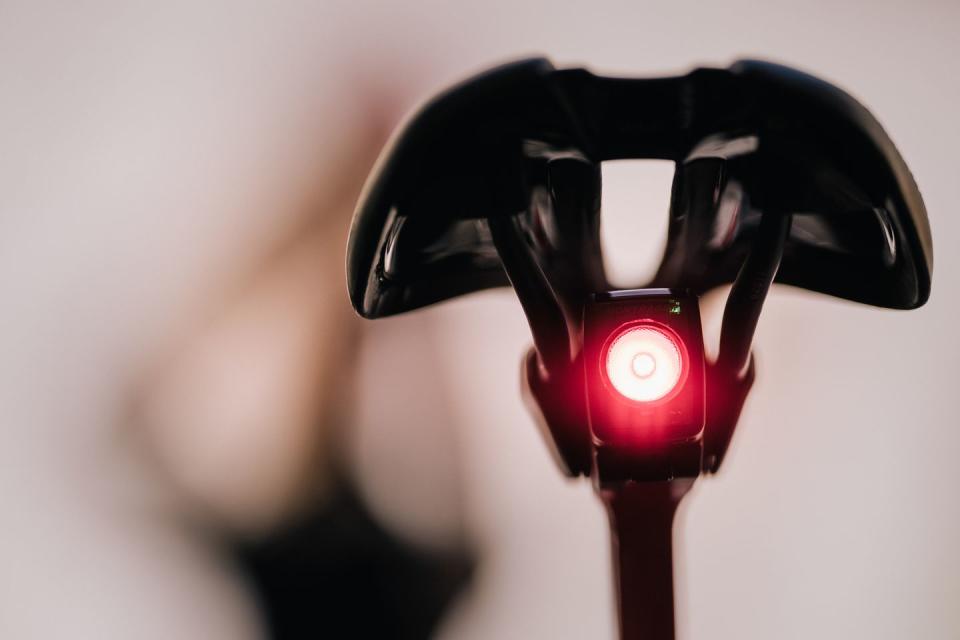
The Madone's "seat post" has been updated as well. The clamping system is now an internal wedge for a cleaner look compared to the previous Madone, and a light mount for Bontrager's Flare R rear light has been integrated as well. The standard post has 25mm of offset; an optional post with 5mm offset will be available.
New Geometry
For several years, Trek has offered its flagship road frames in two geometries. H2 gave riders a little more stack and reach relative to standard road racing geometry. H1 however was intended for limber professional racers. It had very long reaches and very low stacks.
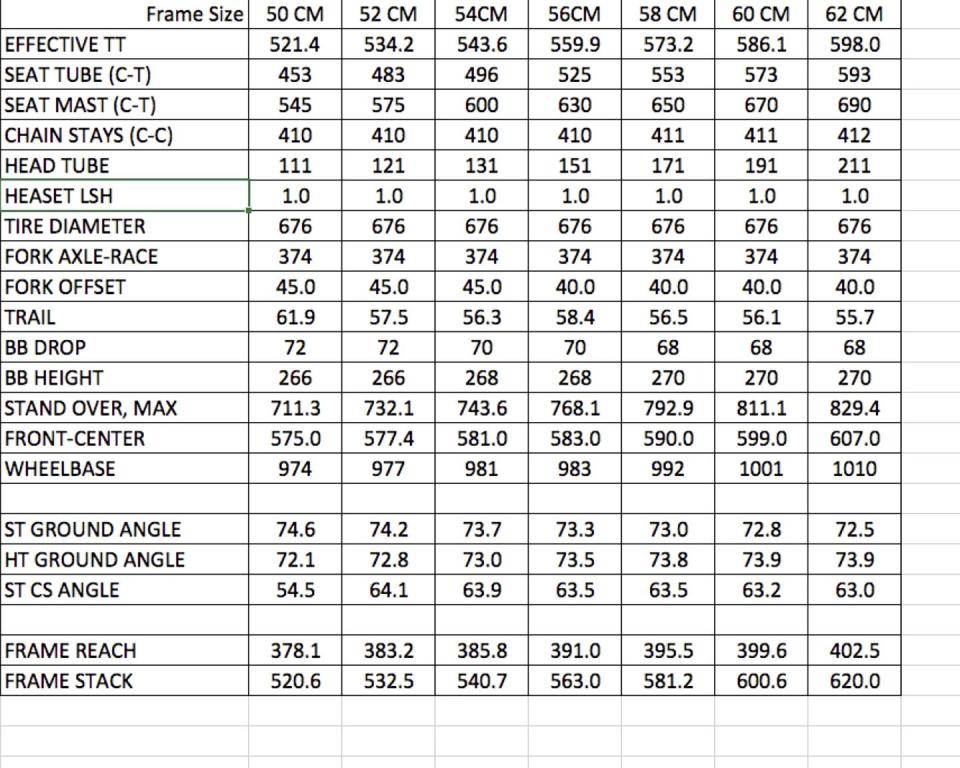
The Madone SLR comes in a new geometry Trek calls H1.5 and it's almost exactly half way between H1 and H2 geometry. It also bring's Treks sizing more in line with its competitors' standard road geometry.

BNG, Baby!
Trek offers stock versions of the new Madone SLR models in standard paint schemes or in fancier premium–AKA Project One Now–paint that incurs a $500 upcharge.
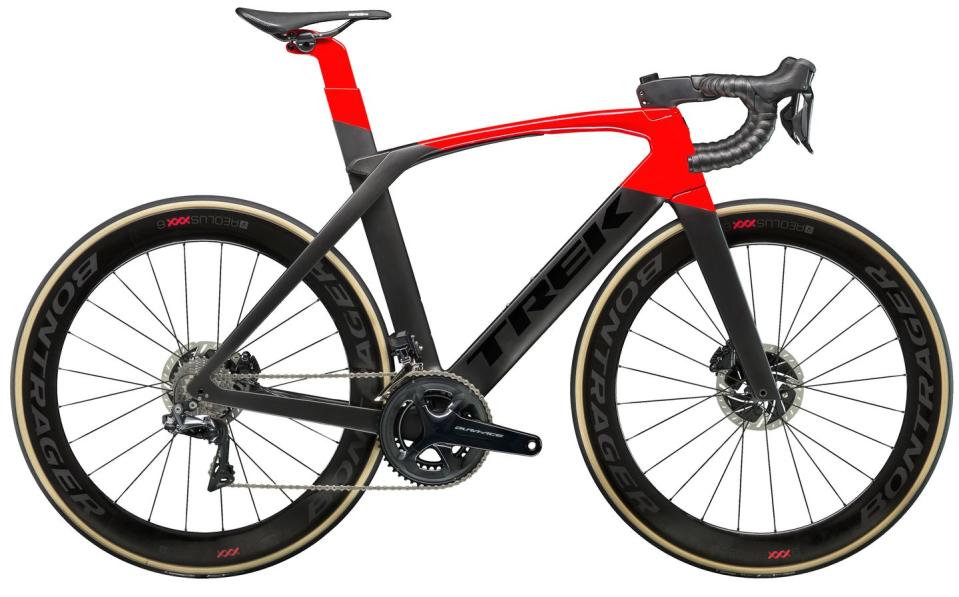
For example, the top-of-the line Madone SLR 9 Disc comes in black with red accents as its standard paint. But you can also get it in a few premium colors: neon yellow and black, sunburst and black, and the Trek Segafredo team replica design.
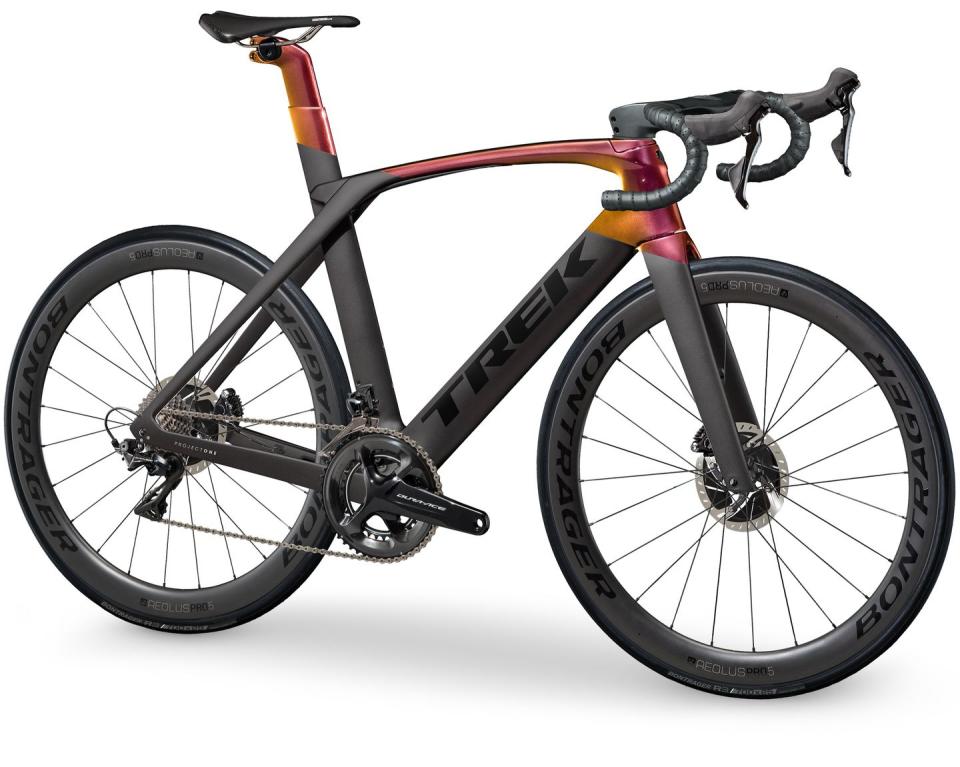
Related: I'd like to congratulate Trek for using the largest logo I've ever seen on a frame. The down tube logo used on the Trek Segafredo and Trek DROPS team paint is a sight to behold.
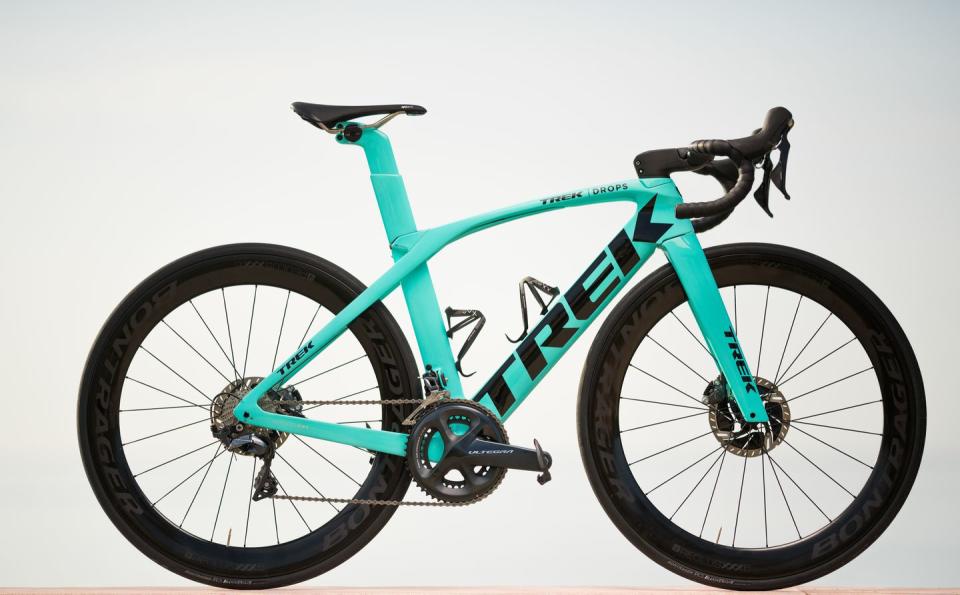
You Might Also Like

